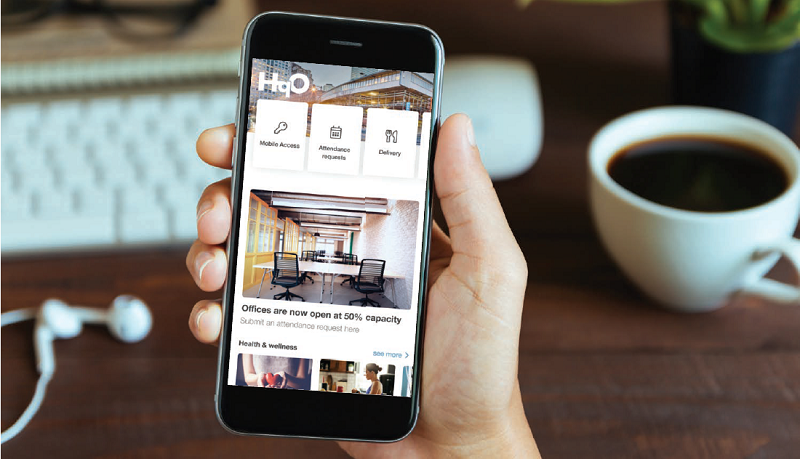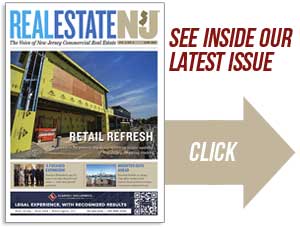HqO, a Boston-based company that offers software to enhance office tenants’ experiences, has seen an increase in demand for its technology, including tools to manage capacity in the office and to directly communicate with workers.
By Kathleen Lynn
Although most office staffers are still working from home during the pandemic, a slice of the New Jersey workforce has returned. Without a doubt, they’ve come back to a changed workplace as landlords take a host of steps to keep them safe and healthy in their buildings.
Those steps involve not only physical upgrades and new on-site technology, but the use of apps and digital platforms aimed at keeping employees informed, engaged and connected.
According to experts, technology can help employers or building owners analyze data that usually is of interest only to the operations or security teams — such as how many people are moving in and out of the building, to make sure there’s plenty of room to space out employees and visitors. For example, BetterSpaces, a company that provides tenant amenities in commercial buildings, said that it limits the number of people at the 650,000-square-foot Glenpointe complex in Teaneck by tracking entries and exits at the door.
Property managers and tenants can use such platforms — along with scheduling software and apps to control lights, doors and elevators — to provide additional layers of assurance.

“How do you weave together these data sets to know what’s going on in the building?” said Doug Stewart, head of the digital buildings practice at Cushman & Wakefield. “You say, ‘I’ve got to take information from different systems and tell a different story based on what we’re trying to do with our COVID response.’ ”
For example, a building might allow 50 percent occupancy, but if some of the employees invite clients or guests for meetings, the building might tip over capacity, he said. That’s something that employers and building management need to know.
By one estimate, about 15 to 20 percent of the New Jersey workforce has returned to the office. Landlords such as Onyx Equities have sought to help them do so safely and confidently with technology such as thermal cameras to take the temperature of anyone who enters the building, along with ultraviolet lights that sanitize elevators and bathrooms.
Both technologies are in place at properties such as the Gateway office complex in Newark, where Onyx and its partners own three of the four buildings at the site. According to Kristen Pappas, the firm’s vice president of property management, equipment such as UV lanterns are not new technology, given that hospitals have long used them to disinfect surfaces.

“The technology has been there — it’s refining the way we use it,” said Pappas, who played an integral role in crafting Onyx’s COVID-19 office repopulation plan. The firm also owns 9 million square feet of office space in the region, with concentrations in Bergen and Morris counties and in New York’s Nassau and Westchester counties.
Stewart said building owners can use sensors to monitor the indoor air quality, which is also an issue during COVID. They can analyze that data with a combination of hardware and software.
To improve air quality, Pappas said, Onyx has upgraded the filters in its HVAC systems.
Experts note that many of the most important workplace safety measures are low-tech, such as requiring masks, increased cleaning, plexiglass barriers around desks and more space between office furniture. That’s not to mention staggered work schedules so there are fewer people around on any given Tuesday.
“Technology can only do a certain part of this — it can inform us,” Stewart said. “You still have to have human behavior change.”
A recent survey by Gensler, an architecture, design and planning firm, found that nationwide, about 29 percent of workers have returned to their offices during the pandemic. But the number is believed to be lower in New Jersey, where the coronavirus hit early and with a death toll estimated at some 17,000 as of early December.

New Jersey officials have told companies to allow employees to work at home when possible. Pappas said that about 20 percent of workers have returned to Onyx’s properties, and based on what she has heard from other property managers, she estimates that roughly 15 to 20 percent of staffers have returned to offices statewide.
Among the technologies that office buildings are using during COVID are mobile apps to run elevators or unlock office doors, so that employees avoid touching surfaces. Similarly, lights can be turned on through motion sensors, rather than a hand on a switch.
Apps are also used to screen employees before they come in to work — by asking them how they’re feeling or asking them to take their temperatures. Meantime, scheduling software can be used for reservation systems, so employees can figure out which days they can go into the office.
And since so many are working at home — and productively, it seems — technology has also been adapted to meet their needs.

“Working from home has proven to be pretty good for a lot of people,” said Janera Soerel, director of business development at BetterSpaces, whose clients include Alfred Sanzari Enterprises and its flagship Glenpointe campus in Teaneck, along with Onyx.
But remote work means employees lose some of what they value most in their workplaces: a sense of connection.
“What we constantly hear is that one of the biggest things that’s nice about the office is that community and interaction,” said Lauren Mead, vice president of marketing for HqO, a Boston-based company that offers software to enhance office tenants’ experiences.
To keep remote employees feeling connected to their colleagues, HqO and BetterSpaces offer phone apps that allow workers to join community-building events over Zoom, such as virtual wine tastings, meditation, fitness and yoga classes and webinars on coping with COVID.
HqO has even helped some clients run virtual food drives, by educating workers over Zoom about a charity’s efforts.

Mead said that, at the beginning of the pandemic, companies held off on adding technology because they were uncertain about what would be needed. But, she said, demand soon rose for HqO’s technology, including tools to manage capacity in the office and to directly communicate with workers.
BetterSpaces also offers technology that allows building managers to communicate directly with users, Soerel said.
As people look to a future return to the office, BetterSpaces is developing an app to help employers and workers manage ride-sharing services, because many workers who normally rely on public transportation are wary of packed buses, trains or subway cars, Soerel said.
Technology has also been a key part of the story as workers swiftly switched to remote work in the early days of the pandemic. Many employees required help with technology — such as better home computer equipment and high-speed internet — to work effectively at home, according to a survey of executives and employees last June by PwC, the tax and consulting firm. The survey found that 55 percent of executives were planning to provide better tech to their remote workers.
Even after vaccines are in wide use and it’s safe to return to the office, a number of surveys show that many employees want to continue working from home at least several days a week, and employers seem inclined to let them. That could point to continued use of technology for connecting remote workers.










